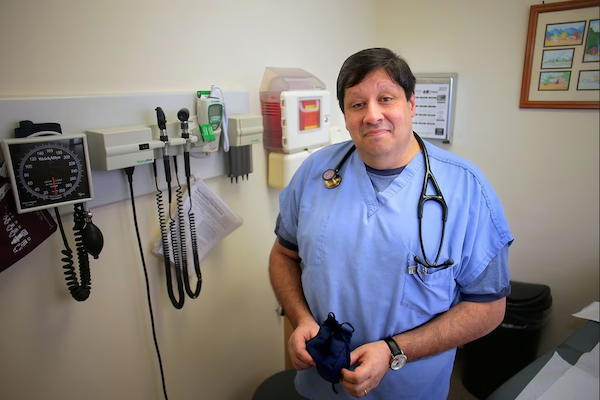Why you can’t get in to see your primary care doctor. ‘It’s almost frightening.’

DATE: February 6, 2023
A wave of retirements, growing patient demand, and changing patterns of well visits are behind the crunch.

Dr. Chris Garofalo said his patients often have trouble getting in to see specialists and then return to primary care to get their needs addressed more urgently, crowding out others.
By Jessica Bartlett Globe Staff,Updated February 5, 2023, 4:28 p.m.
Across Massachusetts, people have been struggling to make appointments with primary care physicians, with doctors saying demand is higher than ever at a time when an increasing number of providers are leaving the field.
The problems are further straining the state’s health care system, potentially leaving patients sicker and in need of more intensive care down the road.
“The only way to provide high-quality, low-cost care is if you have a robust primary care system,” said Barbra Rabson, CEO of Massachusetts Health Quality Partners, a nonprofit that is working to improve patients’ experiences. “We know the primary care system is increasingly unstable. When you look at the combination of factors, it’s almost frightening.”
The reasons for the primary care crunch include rising rates of retirement, not enough MDs entering the field, growing demand for care from a sicker population, and changes in the patterns of well visits since the start of the pandemic.
In response, the state has begun chronicling the health of the industry as it seeks to pinpoint policy decisions and further investment. Late last month, the Center for Health Information and Analysis, a state agency that studies the health care industry, in collaboration with the Massachusetts Health Quality Partners, released new data that highlight the challenges the system is facing.
In 2020, 3.6 percent of primary care physicians left the profession — higher than the national rate of 3.3 percent. And one third of primary care doctors were over the age of 60 that year, a slight increase from 2018.
Meanwhile, the share of people who said they had difficulty accessing necessary health care grew to 33.9 percent in 2021, from 32.4 percent in 2019, and rates of avoidable emergency department use grew as well.
Those who identify as Black or Hispanic reported the most difficulty accessing primary care. In 2021, only 64 percent of Hispanic residents, 70.3 percent of Black residents, and 73.7 percent of Asian residents reported that they had a preventive care visit in the last 12 months, compared with 81 percent of white residents. Patient advocacy groups say the situation has become so dire in immigrant communities that some children have been unable to attend school or day care because they couldn’t get their annual physicals and vaccinations.
Mara De Silva, a counselor at patient advocacy organization Health Care For All, said patients on MassHealth who speak no English have the most trouble getting appointments. Despite requirements for providers who accept MassHealth to make translation services available, many do not. If De Silva can find a provider with an opening, sometimes they call to confirm the appointment in English and cancel it when the patient cannot understand the request.
“If we don’t have a strong foundation here, we won’t keep people from getting sick, and when they get sick we won’t easily restore them to health,” said Ann Greiner, CEO of Primary Care Collaborative.
There has long been an underinvestment in primary care. The Center for Health Information and Analysis report found primary care spending represented less than 8 percent of overall medical spending and had declined across insurance categories from 2019 to 2020.
Salaries for primary care physicians and pediatricians also fall in the middle to lower end of average salaries for all Massachusetts physicians, and, in 2022, only 23.6 percent of students graduating from Massachusetts medical schools planned to go into primary care.
The pandemic has also accelerated the departure of providers, many say. In addition to retirements, some physicians have left clinical medicine altogether or gone to work for pharmaceutical companies or to get their business degrees. Staffing shortages have compounded the difficulty of the work, contributing to burnout and causing more physicians to leave.
“They are leaving because it’s less enjoyable to practice with short visits where you know you’re not able to meet all the needs of your patient,” said Greiner. “And there’s a high administrative burden — studies show two hours of paperwork and reporting for one hour of clinical care. That’s not a lot of fun.”
Greiner also said different avenues for providers might be taking them away from the traditional primary care practice. A growing number of practices specialize in specific populations, such as people on Medicare. That takes providers who used to serve larger pools of diverse patients out of the market.
Increasing consolidation in the market has also contributed to access problems, Greiner said. When formerly independent practices become part of a larger system, physician patient loads typically grow. While that might mean more slots for new patients, it can make it harder to get in for a visit when something urgent comes up.
Backlogs in specialty care also impact primary care doctors. Dr. Chris Garofalo, a family medicine physician in North Attleborough, said he has noticed a dramatic increase in the wait times for his patients to see specialists over the last six to nine months. Patients then return to primary care to get their needs addressed more quickly, which takes up spots for other patients.
“The backlogs cascade on one another,” Garofalo said.
As more physicians leave the field, demand for services has escalated. The pandemic disrupted normal patterns of annual well visits, pushing many to occur in the fall and early winter, after initial pandemic lockdowns lifted in 2020. But that catch-up in the months after the pandemic has now locked in many patients to annual physicals all happening at the same time. With more annual physicals scheduled at certain times of year, access can be challenging for more urgently needed care.
Dr. Lara Jirmanus, a primary care physician in Revere, said patients are also sicker, due to delays in seeking care during the height of the pandemic. With much of the population having contracted COVID, and upwards of a fifth of infected residents developing long COVID, that too has increased demand. Other providers said waves of flu and RSV have brought even more people in looking for appointments.
“For those that are coming in, they have multiple medical issues that can’t be addressed in a single visit,” Jirmanus said. “It’s created essentially a backlog of people who had been delaying care.”
Changing ways of caring for patients have also encroached on physicians’ time. Garofalo said insurers have called for increasing amounts of screenings, such as those for depression and oral health, and physicians also have to navigate prior authorization approvals so patients’ insurance plans will cover certain services or medications.
Bernard Jones, vice president of primary and value-based care, public policy, and administrative operations for Brigham & Women’s Hospital, said providers are also expected to be more digitally accessible than ever. He recalled one provider who told him after dedicating two hours to answering electronic messages from patients, the number of messages in her inbox had actually grown — from 160 to 180.
“I have very dedicated physicians who say if anything pushes me out, it will be the ‘inbasket,’” Jones said.
